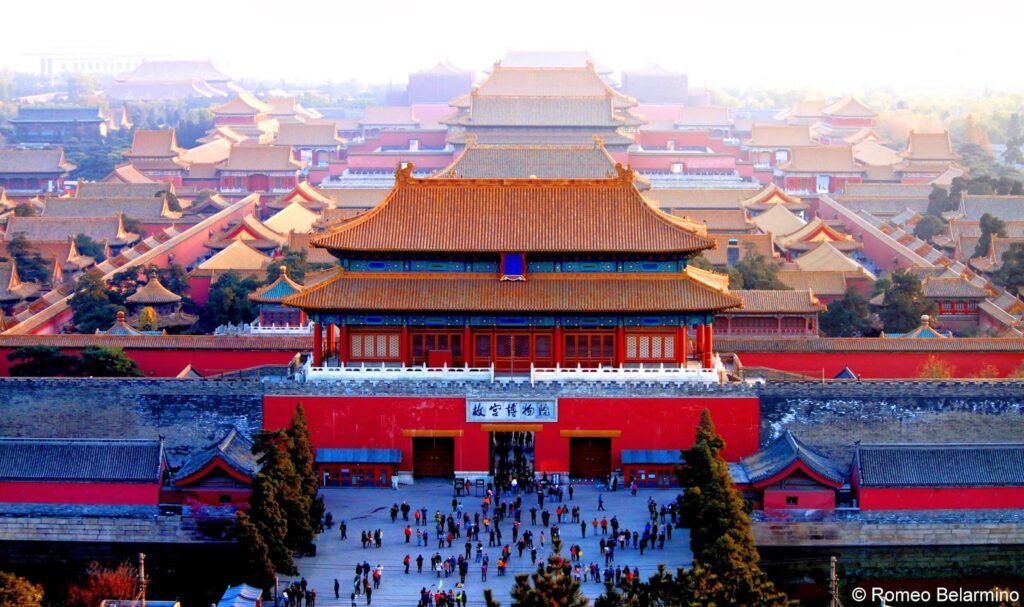
Nestled at the heart of Beijing, China, lies an architectural marvel that transcends time and space – the Forbidden City. This majestic complex, also known as the Palace Museum, stands as a testament to China’s rich history, culture, and imperial legacy. Spanning over 180 acres and boasting more than 8,700 rooms, the Forbidden City is not just a tourist destination; it’s a journey back in time, offering a glimpse into the opulent world of ancient Chinese emperors.
Unveiling the Forbidden City
The Forbidden City, known as “Zijin Cheng” in Chinese, translates to the “Purple Forbidden City.” Construction began in 1406 during the Ming Dynasty and was completed in 1420, serving as the imperial palace for 24 emperors from the Ming to the Qing Dynasty. Enclosed by towering walls and surrounded by a moat, the Forbidden City was aptly named, as access was strictly limited to the emperor, his family, and select court officials.
A Glimpse into Imperial Life
Stepping through the towering vermilion gates of the Forbidden City, visitors are transported into a world of imperial grandeur. The architecture is a harmonious blend of traditional Chinese design principles, with intricate carvings, vibrant hues, and symbolic motifs adorning every surface. The layout of the Forbidden City follows the principles of Feng Shui, with the main buildings aligned along a north-south axis, symbolizing the connection between heaven and earth.
Highlights of the Forbidden City
1. Hall of Supreme Harmony (Taihedian)
As the largest and most important building in the Forbidden City, the Hall of Supreme Harmony served as the ceremonial center of imperial power. Its grandeur is evident in its towering triple-tiered roof, intricately carved dragon motifs, and imposing marble throne. Within its halls, the emperor would conduct state affairs, hold grand ceremonies, and receive foreign dignitaries.
2. Hall of Mental Cultivation (Yangxindian)
Unlike the ceremonial halls, the Hall of Mental Cultivation served as the private residence of the emperor during the Qing Dynasty. This intimate space offers a glimpse into the personal life of the emperor, with intricately furnished chambers, private gardens, and a study where the emperor would conduct state affairs.
3. Imperial Gardens (Yuhuayuan)
Escape the hustle and bustle of the palace and explore the tranquil beauty of the Imperial Gardens. Designed to emulate the mythical gardens of immortals, this lush oasis features winding pathways, elegant pavilions, and serene lakes adorned with lotus flowers. It’s the perfect place to relax and reflect amidst the splendor of the Forbidden City.
Preserving Cultural Heritage
In 1925, the Forbidden City was transformed into the Palace Museum, opening its doors to the public and serving as a repository of China’s cultural heritage. Today, it houses over 1.8 million artifacts, including exquisite porcelain, ancient paintings, imperial robes, and rare manuscripts, providing invaluable insights into China’s imperial past.
Visitor Information
Opening Hours
The Forbidden City is open to visitors year-round, with slightly reduced hours during the winter months. It’s advisable to check the official website for up-to-date information on opening hours and ticket prices.
Getting There
Located in the heart of Beijing, the Forbidden City is easily accessible by public transportation, including subway, bus, and taxi. Visitors can also opt for guided tours, which provide insight into the history and significance of this iconic landmark.
Tips for Visitors
- Wear comfortable shoes, as the Forbidden City covers a vast area, and you’ll be doing a lot of walking.
- Bring plenty of water and sunscreen, especially during the summer months, as Beijing’s climate can be hot and humid.
- Respect the cultural significance of the Forbidden City by adhering to dress codes and following instructions from museum staff.
Conclusion
The Forbidden City stands as a living testament to China’s imperial past, offering visitors a rare opportunity to step back in time and explore the grandeur of ancient dynasties. From its majestic halls to its serene gardens, every corner of this UNESCO World Heritage Site tells a story of power, prestige, and cultural innovation. Whether you’re a history enthusiast, an architecture buff, or simply a curious traveler, a visit to the Forbidden City is sure to leave a lasting impression, as you embark on a journey through China’s imperial splendor.
